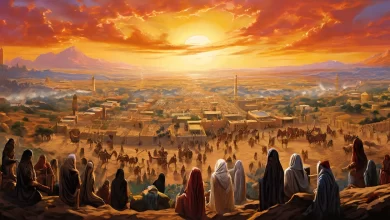The History of Lebanon from Antiquity to the Formation of Modern Lebanon
Introduction
A small country located in the Middle East, Lebanon is a land of great contrasts and a rich historical tapestry. Although it is one of the smallest countries in the world, with an area of just 10,452 km² and an estimated population of around 5.8 million, its history dates back more than 8,000 years. Stretching along the coast of the Mediterranean Sea, Lebanon has been a meeting point for diverse cultures and civilizations, having been shaped by invasions, trade and social transformations that have made it one of the most fascinating places in the world.
In this article, we will walk through the history of Lebanon, from the first evidence of human habitation in the region, through the Phoenician and Roman civilizations, to the formation of modern Lebanon. Join us on this journey through the history of Lebanon, which continues to be one of the focal points of politics and culture in the Middle East.
Early Civilizations in Lebanon
The history of Lebanon dates back long before the founding of its most famous cities, such as Beirut, Tyre, and Sidon. The region is estimated to have been inhabited since around 8,000 B.C., based on archaeological artifacts found in Byblos, one of the oldest cities in the world, which has been continuously inhabited since 5,000 B.C. Byblos was an important commercial and cultural center, and archaeological excavations reveal that the region’s earliest inhabitants were hunters and gatherers, with fauna including wild goats, fallow deer, and even narrow-nosed rhinos.
Around 3,000 B.C., Byblos grew from a small fishing village into a thriving city, marking the beginning of one of the first urban civilizations in the Levant. During this period, Semitic tribes began to settle on the coast and in the mountains of Lebanon, founding new cities such as Beirut, Tyre, and Sidon.

Canaanite Culture and the Rise of the Phoenicians
Around 2,500 B.C., the region of Lebanon was part of the land of Canaan, which would later become known as Phoenicia. The Canaanites, a Semitic people, developed a highly sophisticated culture, with great advances in agriculture, art, and commerce. It was during this period that Phoenician cities began to emerge as trading powers in the Mediterranean. Tyre, Sidon, and Byblos were known for their skill in navigation and maritime trade, becoming commercial centers that traded with civilizations as far away as Greece and Egypt.
Phoenicia was a land of small, independent kingdoms, but united by their language, culture, and religion. The Phoenicians were known for their skill as seafarers and their ability to navigate great distances. The city of Tyre, for example, became one of the wealthiest and most powerful centers of the ancient world, thanks to its influence in maritime trade.
Egyptian and Assyrian Rule
The Levant region, including Lebanon, has been under the rule of various foreign powers over the centuries. During the second millennium BC, Egypt exerted great influence over Phoenicia, establishing its rule over the Phoenician cities. In 1450 BC, the Phoenicians submitted to Egyptian rule, paying tribute and serving the pharaoh. However, Egyptian influence waned over time, and the Phoenicians, known for their commercial prowess, managed to maintain a certain autonomy.
Around 858 BC, the Assyrian king Shalmaneser III began a series of military campaigns against the Phoenician cities, bringing much of the region under Assyrian rule. The resistance of the Phoenician cities was notable, with Tyre and Sidon offering resistance to the Assyrian invaders. However, by 721 BC, most of Phoenicia had been annexed by the Assyrians.

Phoenicia under Babylonian and Persian Rule
After the fall of the Assyrian Empire, Phoenicia came under the control of the Babylonian Empire. The Babylonians, under the command of Nabopolassar and Nebuchadnezzar II, maintained control over the region, but the Phoenician cities actively resisted this rule, maintaining a certain autonomy until 573 BC, when they finally submitted to Babylonian rule.
In 539 BC, the Babylonian Empire was defeated by the Persians, led by Cyrus the Great. Phoenicia was incorporated into the Achaemenid Empire and divided into four vassal kingdoms: Sidon, Tyre, Arawak, and Byblos. Although Lebanon was under Persian rule, the Phoenicians continued to be important to the Persians, especially for their ability to build naval fleets. During the Greco-Persian Wars, the Phoenicians played a key role in supplying the bulk of the Persian fleet.
Alexander the Great’s Conquest and Hellenization
In 332 BC, Alexander the Great began his military campaign in the Middle East, conquering Phoenicia after a long siege of the city of Tyre. With the fall of the city, the other Phoenician cities were easily conquered. Hellenization, the process by which Greek cultures were imposed on conquered peoples, did not profoundly affect Phoenicia. The Phoenician cities retained their names and cultures, although under Greek administration.
After Alexander’s death in 323 BC, the region came under the control of his generals, including Antigonus, who ruled the area as part of the Seleucid Empire. During this period, the Phoenician cities were fought over by the Seleucids and the Ptolemaics of Egypt, but the region remained an important center of Mediterranean trade.
The Roman Empire and Christianity
With the rise of Rome, the region of Phoenicia, including Lebanon, was absorbed into the Roman Empire. During the Pax Romana, the Phoenician cities prospered economically. Sidon, Tyre, and Byblos continued to be centers of pottery, glass, and purple dye. The city of Beirut, for example, became a strategically important Roman colony.
It was during Roman rule that Christianity spread to Lebanon. From the 1st century AD, Christianity was introduced to the region and quickly became a major religion. The city of Beirut became a center of early Christianity, and Lebanese Christians played a key role in spreading the Christian faith.
Lebanon under Muslim and Ottoman Rule
In the 7th century, Lebanon was conquered by the Muslims of the Rashidun Caliphate, who established the province of Bilad al-Sham, including the Levant region. Muslim rule had a significant impact on the region, but the Lebanese mountains continued to be a refuge for Christians and other religious minorities.
During the medieval period, Lebanon was under the control of several Muslim dynasties, including the Umayyads, Abbasids, and Fatimids. The Ottoman Empire, which ruled much of the Middle East for over 400 years, also had a major influence in the region.
Modern Lebanon and the 20th Century
From the 19th century onwards, Lebanon began to distinguish itself from other territories under Ottoman rule, with growing demands for autonomy and the formation of a national identity. After World War I, Lebanon was placed under a French mandate by the League of Nations. The country gained independence in 1943, and since then, Lebanon’s history has been marked by periods of conflict and peace, with the Lebanese Civil War (1975-1990) being one of the most traumatic events in the country’s recent history.
Following the Civil War, Lebanon underwent a long process of reconstruction, but the country still faces significant challenges, including sectarian tensions, economic challenges, and the presence of militant groups.
Conclusion
The history of Lebanon is one of resistance, resilience, and transformation. From the ancient Phoenician civilizations to modern challenges, Lebanon remains a land of great historical and cultural significance. The region has been the scene of encounters between diverse cultures, religions, and empires, which has shaped its unique identity. Lebanon’s future, while challenging, remains an ongoing story, with the Lebanese striving to preserve their heritage and move toward a future of peace and prosperity.



